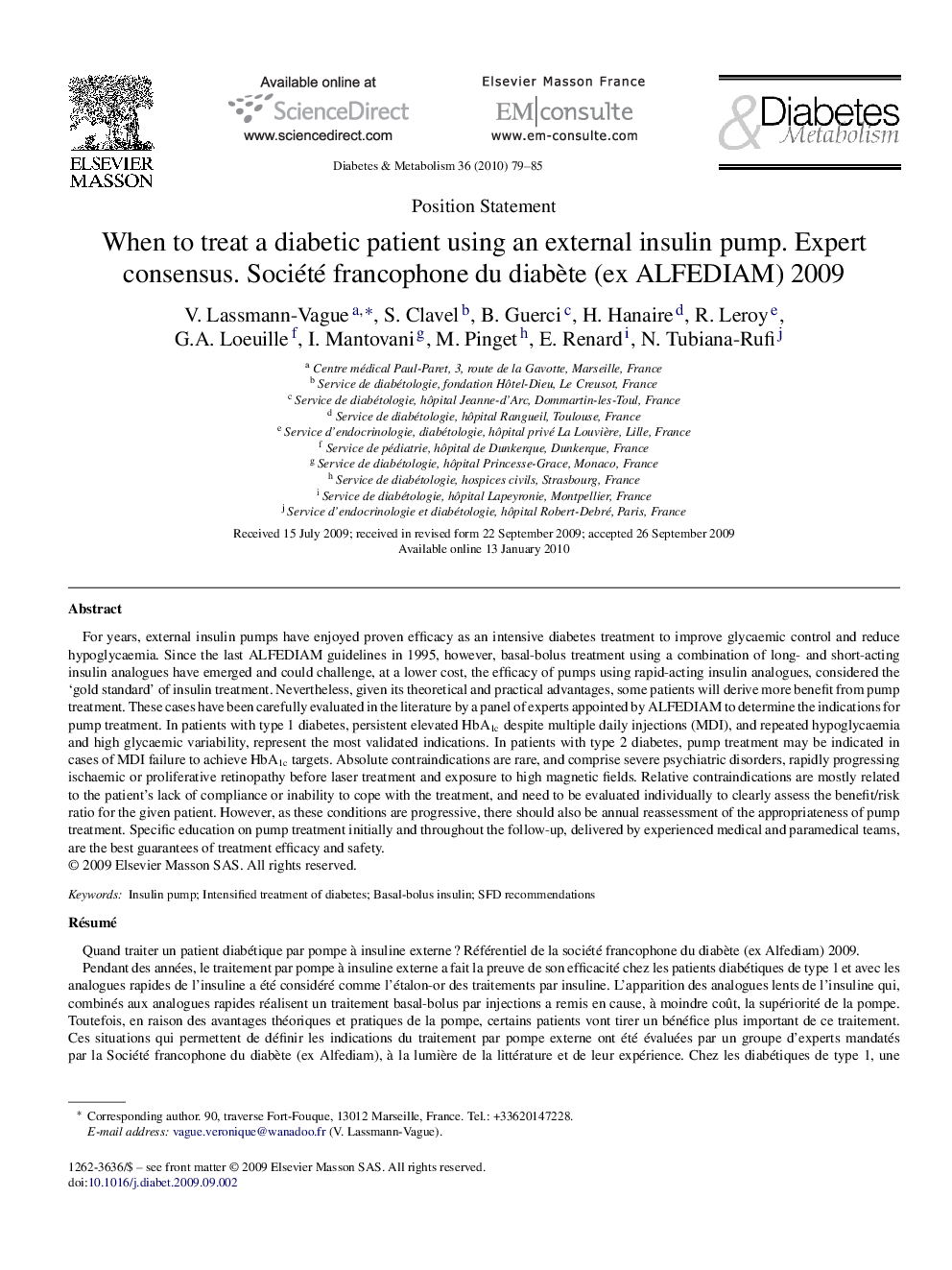| کد مقاله | کد نشریه | سال انتشار | مقاله انگلیسی | نسخه تمام متن |
|---|---|---|---|---|
| 3260401 | 1207620 | 2010 | 7 صفحه PDF | دانلود رایگان |

For years, external insulin pumps have enjoyed proven efficacy as an intensive diabetes treatment to improve glycaemic control and reduce hypoglycaemia. Since the last ALFEDIAM guidelines in 1995, however, basal-bolus treatment using a combination of long- and short-acting insulin analogues have emerged and could challenge, at a lower cost, the efficacy of pumps using rapid-acting insulin analogues, considered the ‘gold standard’ of insulin treatment. Nevertheless, given its theoretical and practical advantages, some patients will derive more benefit from pump treatment. These cases have been carefully evaluated in the literature by a panel of experts appointed by ALFEDIAM to determine the indications for pump treatment. In patients with type 1 diabetes, persistent elevated HbA1c despite multiple daily injections (MDI), and repeated hypoglycaemia and high glycaemic variability, represent the most validated indications. In patients with type 2 diabetes, pump treatment may be indicated in cases of MDI failure to achieve HbA1c targets. Absolute contraindications are rare, and comprise severe psychiatric disorders, rapidly progressing ischaemic or proliferative retinopathy before laser treatment and exposure to high magnetic fields. Relative contraindications are mostly related to the patient's lack of compliance or inability to cope with the treatment, and need to be evaluated individually to clearly assess the benefit/risk ratio for the given patient. However, as these conditions are progressive, there should also be annual reassessment of the appropriateness of pump treatment. Specific education on pump treatment initially and throughout the follow-up, delivered by experienced medical and paramedical teams, are the best guarantees of treatment efficacy and safety.
RésuméPendant des années, le traitement par pompe à insuline externe a fait la preuve de son efficacité chez les patients diabétiques de type 1 et avec les analogues rapides de l’insuline a été considéré comme l’étalon-or des traitements par insuline. L’apparition des analogues lents de l’insuline qui, combinés aux analogues rapides réalisent un traitement basal-bolus par injections a remis en cause, à moindre coût, la supériorité de la pompe. Toutefois, en raison des avantages théoriques et pratiques de la pompe, certains patients vont tirer un bénéfice plus important de ce traitement. Ces situations qui permettent de définir les indications du traitement par pompe externe ont été évaluées par un groupe d’experts mandatés par la Société francophone du diabète (ex Alfediam), à la lumière de la littérature et de leur expérience. Chez les diabétiques de type 1, une HbA1c élevée de façon répétée malgré les multi-injections, des hypoglycémies répétées, et une variabilité glycémique importante représentent les indications les plus validées. Chez le diabétique de type 2, en cas d’échec des multi-injections, un traitement par pompe peut être proposé. Les contre-indications absolues au traitement par pompe sont rares : maladies psychiatriques graves, rétinopathie ischémique sévère rapidement évolutive ou proliférante non traitée par laser, exposition à des champs magnétiques intenses. Les contre-indications relatives sont essentiellement liées au manque d’observance du patient ou à son incapacité à gérer ce traitement. Elles seront appréciées cas par cas afin d’évaluer le rapport bénéfices/risques pour chaque patient. Toutes ces situations peuvent évoluer, ce qui souligne l’importance de la réévaluation annuelle de la pertinence du traitement par pompe. Une éducation thérapeutique spécifique délivrée au sein d’un environnement médical et paramédical expérimenté garantit au mieux l’efficacité du traitement et la sécurité du patient.
Journal: Diabetes & Metabolism - Volume 36, Issue 1, February 2010, Pages 79–85